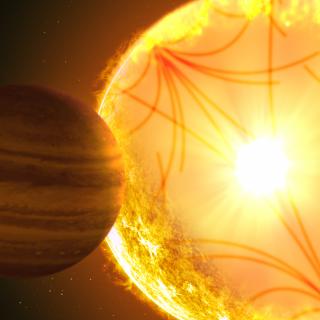Bibcode
Borsato, L.; Degen, D.; Leleu, A.; Hooton, M. J.; Egger, J. A.; Bekkelien, A.; Brandeker, A.; Collier Cameron, A.; Günther, M. N.; Nascimbeni, V.; Persson, C. M.; Bonfanti, A.; Wilson, T. G.; Correia, A. C. M.; Zingales, T.; Guillot, T.; Triaud, A. H. M. J.; Piotto, G.; Gandolfi, D.; Abe, L.; Alibert, Y.; Alonso, R.; Bárczy, T.; Navascues, D. Barrado; Barros, S. C. C.; Baumjohann, W.; Beck, T.; Bendjoya, P.; Benz, W.; Billot, N.; Broeg, C.; Busch, M. -D.; Csizmadia, Sz.; Cubillos, P. E.; Davies, M. B.; Deleuil, M.; Deline, A.; Delrez, L.; Demangeon, O. D. S.; Demory, B. -O.; Derekas, A.; Edwards, B.; Ehrenreich, D.; Erikson, A.; Fortier, A.; Fossati, L.; Fridlund, M.; Gazeas, K.; Gillon, M.; Güdel, M.; Heitzmann, A.; Helling, Ch.; Hoyer, S.; Isaak, K. G.; Kiss, L. L.; Korth, J.; Lam, K. W. F.; Laskar, J.; Lecavelier des Etangs, A.; Lendl, M.; Magrin, D.; Marafatto, L.; Maxted, P. F. L.; Mecina, M.; Mékarnia, D.; Mordasini, C.; Mura, D.; Olofsson, G.; Ottensamer, R.; Pagano, I.; Pallé, E.; Peter, G.; Pollacco, D.; Queloz, D.; Ragazzoni, R.; Rando, N.; Ratti, F.; Rauer, H.; Ribas, I.; Salmon, S.; Santos, N. C.; Scandariato, G.; Ségransan, D.; Simon, A. E.; Smith, A. M. S.; Sousa, S. G.; Stalport, M.; Suarez, O.; Sulis, S.; Szabó, Gy. M.; Udry, S.; Van Grootel, V.; Venturini, J.; Villaver, E.; Walton, N. A.; Wolter, D.
Referencia bibliográfica
Astronomy and Astrophysics
Fecha de publicación:
9
2024
Revista
Número de citas
12
Número de citas referidas
10
Descripción
Context. Among the thousands of exoplanets discovered to date, approximately a few hundred gas giants on short-period orbits are classified as 'lonely' and only a few are in a multi-planet system with a smaller companion on a close orbit. The processes that formed multi-planet systems hosting gas giants on close orbits are poorly understood, and only a few examples of this kind of system have been observed and well characterised. Aims. Within the contest of a multi-planet system hosting a gas giant on short orbits, we characterise the TOI-1130 system by measuring masses and orbital parameters. This is a two-transiting planet system with a Jupiter-like planet (c) on a 8.35 days orbit and a Neptune-like planet (b) on an inner (4.07 days) orbit. Both planets show strong anti-correlated transit timing variations (TTVs). Furthermore, radial velocity (RV) analysis showed an additional linear trend, a possible hint of a non-transiting candidate planet on a far outer orbit. Methods. Since 2019, extensive transit and radial velocity observations of the TOI-1130 have been acquired using TESS and various ground-based facilities. We present a new photo-dynamical analysis of all available transit and RV data, with the addition of new CHEOPS and ASTEP+ data, which achieve the best precision to date on the planetary radii and masses and on the timings of each transit. Results. We were able to model interior structure of planet b constraining the presence of a gaseous envelope of H/He, while it was not possible to assess the possible water content. Furthermore, we analysed the resonant state of the two transiting planets, and we found that they lie just outside the resonant region. This could be the result of the tidal evolution that the system underwent. We obtained both masses of the planets with a precision of less than 1.5%, and radii with a precision of about 1% and 3% for planet b and c, respectively. ★This study uses CHEOPS data observed as part of the Guaranteed Time Observation (GTO) programmes CH_PR00015, CH_PR00031, and CH_PR00053.
Proyectos relacionados

Sismología Solar y Estelar y Búsqueda de Exoplanetas
Los objetivos genéricos de este Proyecto son: 1) el estudio de la estructura y dinámica del interior solar, 2) la extensión de dicho estudio al caso de otras estrellas, 3) la búsqueda y caracterización de planetas extrasolares por métodos fotométricos (principalmente mediante el método de tránsitos) y espectroscópico (variaciones en la velocidad
Savita
Mathur

Exoplanetas y Astrobiología
La búsqueda de vida en el Universo se ha visto impulsada por los recientes descubrimientos de planetas alrededor de otras estrellas (los llamados exoplanetas), convirtiéndose en uno de los campos más activos dentro de la Astrofísica moderna. En los últimos años los descubrimientos cada vez más numerosos de nuevos exoplanetas y los últimos avances
Enric
Pallé Bago